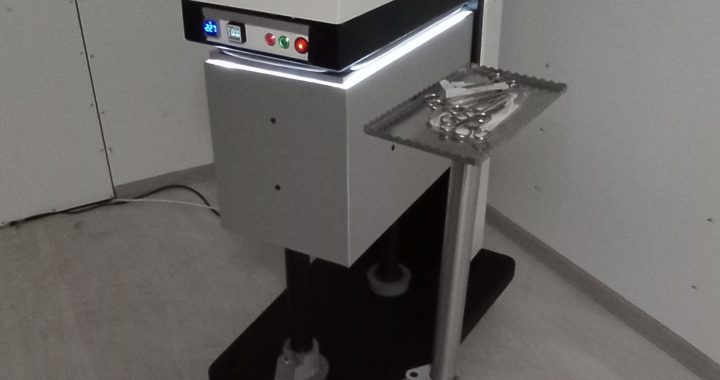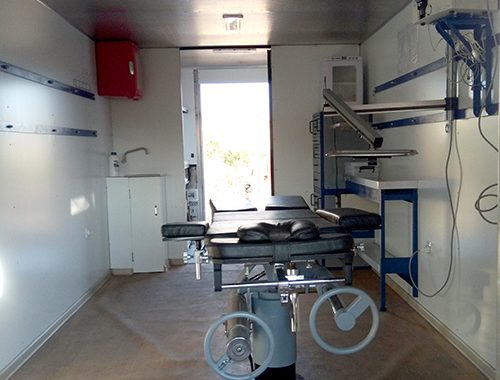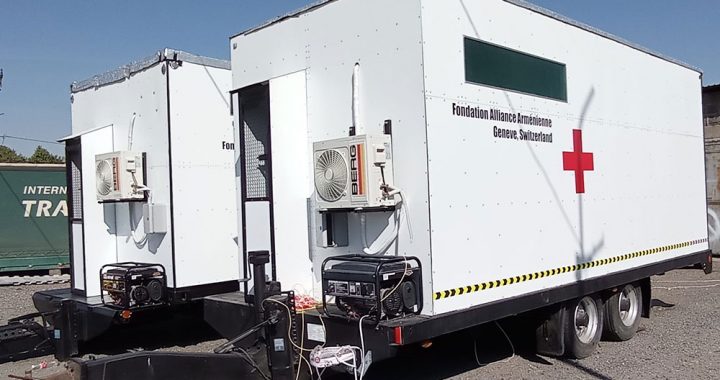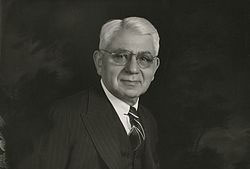Innovative coal combustion technology without emissions and additional energy

Smoke billows from several chimneys at a factory in Jilin, in north China's Jilin province on November 29, 2009. The EU said on November 30 cataclysmic climate change cannot be averted without Chinese leadership, as the two sides wrapped up a summit with China defending its efforts against global warming. CHINA OUT AFP PHOTO (Photo credit should read AFP/AFP/Getty Images)
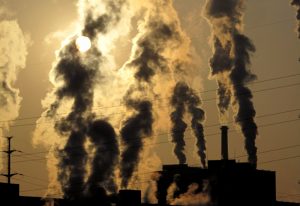
The “Noyan Tapan” Foundation presents innovative-breakthrough technologies aimed at obtaining useful chemicals from combustible combustion products, as well as saving hydrocarbon fuel.
The foundation is developing a number of innovative and groundbreaking technologies aimed at converting the products of combustion of natural gas and other hydrocarbons into other useful substances, including liquid fuel, which are essentially saving burning fuel, which are going to enter the market.
A-5 system
The A-5 technology chain is designed for the combustion of coal and the conversion of flue gases from that combustion into industry and chemicals required in the economy. Operates without additional energy costs for that purpose.
System A-5 is a technology system based on the combustion of coal, which generally eliminates emissions into the atmosphere and allows in addition to the target thermal energy to receive a number of useful chemicals, including hydrogen (H2), nitrogen (N2), nitric acid ( HNO3), sulfuric acid (H2SO4), methanol (CH3OH), etc …
Innovations developed by the company, synthesized new catalysts are used in all the nodes of the technological chain of the A-5 system, the use of which makes the described processes possible and economically profitable.
The use of the A-5 system is highly expedient for a large number of countries. and where coal burning has already created a very dangerous environmental situation for human health (for example, China, Russia, etc.), and in countries that have coal reserves and need alternative fuel for cars, such as cheap methanol and hydrogen.
System operation:
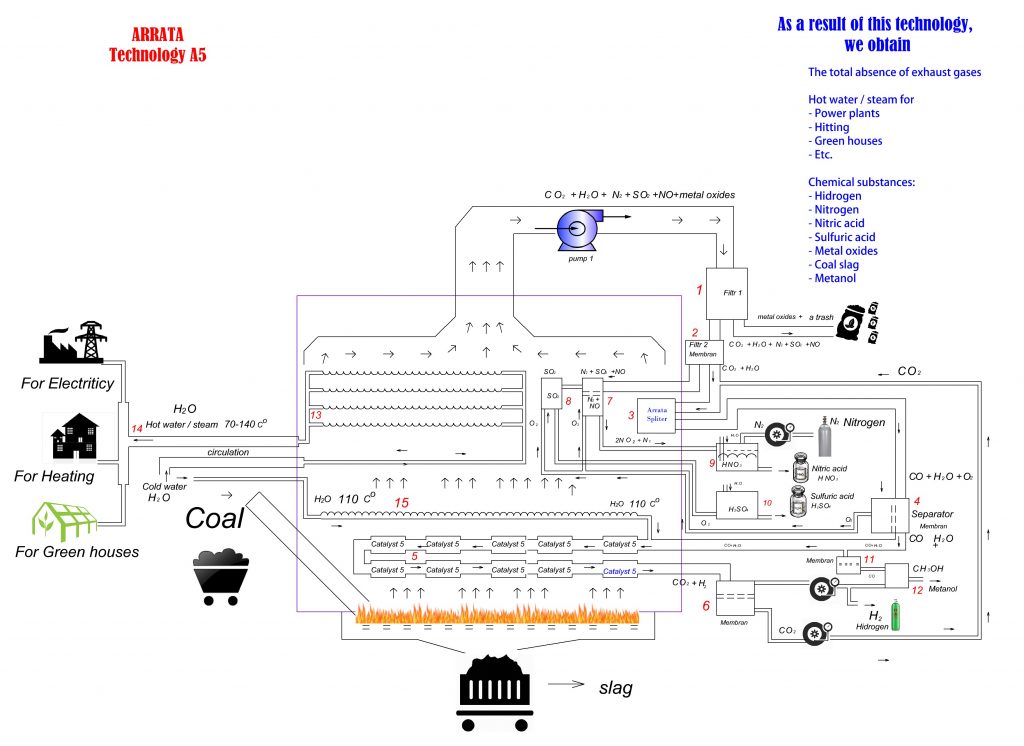
As shown in the diagram, the technological chain begins with a simple coal-fired furnace, in which, in addition to the circulating water system, which performs a useful job, [13] several technological nodes for Aratta’s innovative A-5 system are installed: [3] , [5], [7], [8], [15].
When coal is burned in a furnace to perform its intended function of heating the circulating water for the needs of the consumer, [13] the combustion flue gases are collected after performing the useful combustion work and pumped to the first node of the A-5 system. [1] , which is a filter.
The first node [1] is the first innovation in the A-5 technology chain, which allows to filter heavy metal and other sediments from tobacco gases in relatively small quantities, leaving only carbon dioxide (CO2), nitrogen (N2), water vapor (H2O) inside the system. , sulfur dioxide (SO2) (if the coal used contains sulfur), and nitrogen monoxide (NO) is also possible. The mixture of these gases is pumped to the second node of the A-5 system [2], which is a membrane separator.
The second node [2] also contains innovative approaches and divides the incoming gases into two parts. Nitrogen (N2), nitrogen monoxide (NO) and sulfur dioxide (SO2) go in the first direction, and carbon dioxide (CO2) and water vapor (H2O) in the second direction. The latter are pushed to the Third Node [3] (Aratta divider).
The third node [3] (Aratta Divider) is the most important node of the A-5 system, where due to the breakthrough innovations applied, the thermal energy from the same coal combustion and the innovative carbon catalyst created by the company, carbon dioxide (CO2) is decomposed into carbon (CO). and oxygen (O2). The mixture of these gases together with water vapor (H2O) enters the Fourth Node [4].
The fourth node [4] is a membrane filter developed by Aratta that separates oxygen (O2) and sends it to the seventh [7] and eighth [8] nodes in the combustion chamber, and the carbon monoxide (CO) and water vapor ( H2O) sends to the Fifth node in the combustion chamber.
The fifth node [5] converts the carbon monoxide (CO) and water droplets (H2O), including, if necessary, the additional water vapor (H2O) received through the Fifteenth node [15], converting it to carbon dioxide (CO2) and hydrogen (H2). , which are pushed to the Sixth Garment [6]. All this is possible thanks to another innovative catalyst developed by the company and the heat from the burning of coal.
In the sixth node [6], which is the membrane separator, carbon dioxide (CO2) and hydrogen (H2) are separated from each other. Hydrogen can be used at its discretion by accumulating in cylinders or burning in a furnace, directing some to the Twelfth Node [12] to obtain methanol. Some of the carbon dioxide (CO2) is pumped to the Third Node [3] (Aratta Separator) again to participate in the system, and the other part is pumped to the Twelfth Node [12] to obtain methanol.
Nitrogen (N2), nitrogen monoxide (NO) and sulfur dioxide (SO) from the second node [2] [7]
2) by another special innovative catalyst, by combining with the oxygen obtained in the Fourth Node [4], are converted and separated from each other. Separated nitrogen (N2) and converted nitrogen dioxide (2NO2) are pumped to the Ninth Node [9], and sulfur dioxide (SO2) to the Eighth Node [8].
In the eighth node [8] sulfur dioxide (SO2) combines with the oxygen obtained in the fourth node [4] to form SO3 with another catalyst and is pumped to the tenth node [10].
The ninth node [9] is designed to receive nitrogen and nitric acid. Here nitrogen (N2) separates from nitrogen dioxide (2NO2) and leaves the system. Nitrogen can be pumped into cylinders and used. And 2NO2, when attached to water at this junction, produces nitric acid (HNO3), which can be stored.
The tenth node [10] is designed to produce sulfuric acid (H2SO4). Here SO3 combines with water to form sulfuric acid (H2SO4), which can be stored.
In the eleventh node [11], some of the CO released from the water vapor coming out of the fourth node [4] is pumped to the twelfth node.
In the twelfth node [12] CO combines with hydrogen to form methanol (CH3OH), which can be stored and used as a liquid fuel.
It should be noted once again that all these processes take place in parallel with the direct useful operation of the furnace, in parallel with the production of hot water or water vapor needed by the consumer, which can be used in thermal power plants, heating residential or industrial areas, greenhouses or any other purpose.
Thanks to this technological chain, the burning of coal for energy purposes becomes absolutely harmless to the environment, as there are simply no emissions, and from the obtained chemicals (hydrogen (H2), nitrogen (N2), nitric acid (HNO3), sulfuric acid (H2SO4), methanol (CH3OH), especially hydrogen and methanol are in great demand in industry and energy.
